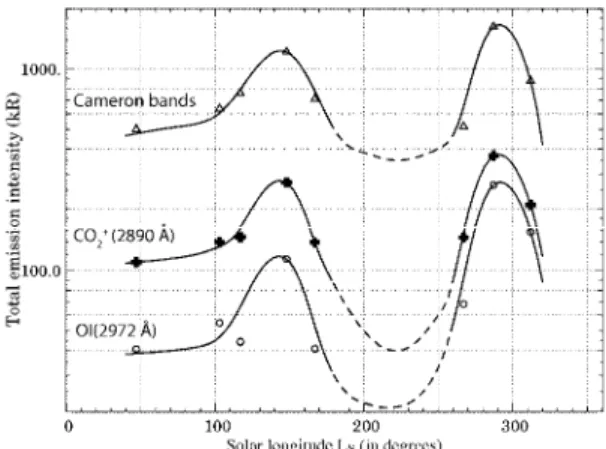HAL Id: insu-00366192
https://hal-insu.archives-ouvertes.fr/insu-00366192
Submitted on 14 Jan 2018
HAL is a multi-disciplinary open access
archive for the deposit and dissemination of
sci-entific research documents, whether they are
pub-lished or not. The documents may come from
teaching and research institutions in France or
abroad, or from public or private research centers.
L’archive ouverte pluridisciplinaire HAL, est
destinée au dépôt et à la diffusion de documents
scientifiques de niveau recherche, publiés ou non,
émanant des établissements d’enseignement et de
recherche français ou étrangers, des laboratoires
publics ou privés.
Observing and modelling Mars’ airglow
Cyril Simon, Olivier Witasse, François Leblanc, Guillaume Gronoff, Jean
Lilensten, Jean-Loup Bertaux
To cite this version:
Cyril Simon, Olivier Witasse, François Leblanc, Guillaume Gronoff, Jean Lilensten, et al..
Observ-ing and modellObserv-ing Mars’ airglow. European Planetary Science Congress 2008, Sep 2008, Münster,
Germany. pp.EPSC2008-A-00111. �insu-00366192�
Observing and modelling Mars' airglow
C. Simon (1), O. Witasse (1), F. Leblanc (2), G. Gronoff (3), J. Lilensten (3), J.-L. Bertaux (4)
(1) Research Scientific Support Department, ESA-ESTEC, Noordwijk, The Netherlands
(cyril.simon@rssd.esa.int), (2) Service d'Aéronomie, Université Paris 6/CNRS, Institut Pierre Simon Laplace, Verrières-le-Buisson, France, (3) Laboratoire de Planétologie de Grenoble, Université Joseph Fourier/CNRS, Grenoble, France, (4) Service d'Aéronomie, Université de Versailles-Saint-Quentin/CNRS, Institut Pierre Simon Laplace, Verrières-le-Buisson, France
Abstract
SPICAM is the UV spectrometer onboard ESA’s Mars Express, which has been recording for more than four years upper atmospheric emissions ([1], [2]). 70000 dayglow limb spectra were analysed using an updated and variable point spread function, yielding altitude profiles of the Cameron bands (a3Π − X1Σ) of CO, the CO2+ ultraviolet doublet (B2Σu+ − X2Πg) at 289 nm and
the oxygen emission at 297.2 nm. The seasonal evolution of these emissions (Fig. 1) exhibits an unexpected increase around LS = 140 degrees, which is
correlated with a sudden increase of neutral densities due to a dust storm event. A comparison with a newly-developed kinetic electron and airglow model ([3], [4]) yields promising results on emission altitude profiles. Improvements on the neutral atmosphere and cross sections are discussed. The new data analysis performed enables the search for faint emissions underlying the main Cameron emission bands. This comparison and analysis work is being extended to nightside auroral emissions using multi-instrument data on Mars Express.
References
[1] Bertaux, J.-L., Korablev, O., Perrier,S., Quémerais, E. and the SPICAM team (2006) JGR, 111, E10S90, doi:10.1029/2006JE002690.
[2] Leblanc, F., Chaufray, J.-Y., Lilensten, J., Witasse, O., Bertaux, J.-L., (2006) JGR, 111, E09S11, doi:10.1029/2005JE002664.
[3] Simon, C., Witasse, O., Leblanc, F., Gronoff, G., Bertaux, J.-L., (2008) submitted to PSS
[4] Gronoff, G., Lilensten, J., Simon, C., Barthélemy, M., Leblanc, F., Dutuit, O., (2008) A.&A. 482, 1015-1029.
Fig. 1 Seasonal evolution of the total emission intensities (in kR) of the Cameron bands, the CO2+ ultraviolet doublet and OI(2972Å). L
S
is the Solar Longitude expressed in degrees. Two peaks are present, one near perihelion (LS ~ 290º), the other during northern spring
(LS ~ 140º) which is correlated with an unexpected dust storm event.
EPSC Abstracts,
Vol. 3, EPSC2008-A-00111, 2008
